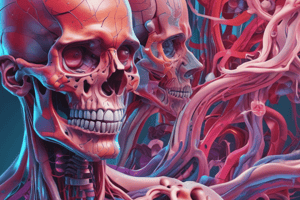Podcast
Questions and Answers
What does the term 'anatomy' mean?
What does the term 'anatomy' mean?
to dissect
What does physiology investigate?
What does physiology investigate?
processes and functions
Which type of physiology studies the human organism?
Which type of physiology studies the human organism?
- Human Physiology (correct)
- Cellular Physiology
- Systemic Physiology
- Anatomical Physiology
What are the four broad types of tissues?
What are the four broad types of tissues?
Anatomical imaging uses technologies like x-rays and MRI.
Anatomical imaging uses technologies like x-rays and MRI.
The basic units of life are called ______.
The basic units of life are called ______.
What is an organ composed of?
What is an organ composed of?
What is the highest level of structural organization in the body?
What is the highest level of structural organization in the body?
Which of the following is NOT a type of anatomy?
Which of the following is NOT a type of anatomy?
Flashcards are hidden until you start studying
Study Notes
Anatomy and Physiology Overview
- Anatomy examines body structures, derived from the term meaning "to dissect."
- Physiology focuses on the processes and functions of the body, with human physiology specifically studying the human organism.
Importance of Anatomy and Physiology
- Critical for understanding body responses to stimuli, environmental changes, diseases, and injuries.
Types of Anatomy
- Systemic Anatomy: Focuses on organ systems of the body.
- Regional Anatomy: Investigates specific body regions, often utilized in medical education.
- Surface Anatomy: Examines external features such as bone projections.
- Anatomical Imaging: Utilizes technologies like X-rays, ultrasounds, and MRI for visualization.
Structural and Functional Organization
- Six Organizational Levels:
- Chemical Level: Smallest unit; includes atoms and molecules.
- Cellular Level: Comprises cells, the basic units of life, containing organelles like mitochondria and the nucleus.
- Tissues: Collection of similar cells; four main types include:
- Epithelial
- Connective
- Muscular
- Nervous
- Organs: Composed of two or more tissue types working together; examples include the stomach, heart, and kidneys.
- Organ Systems: Groups of organs functioning together, such as the digestive and reproductive systems.
- Organism: Represents the complete entity with all organ systems collaborating, including microorganisms like intestinal bacteria.
Studying That Suits You
Use AI to generate personalized quizzes and flashcards to suit your learning preferences.




